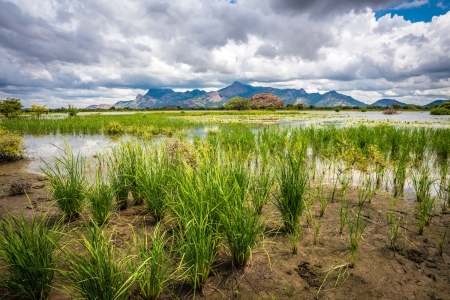Here's Why Sustainable Rice Cultivation Is Better For The Environment
Rice is a staple food for over half of the world’s population. There are many varieties of rice cultivated around the globe, and this ubiquitous crop plays a vital role in providing nourishment and income for millions.
Rice requires ample water to grow, but it can thrive in many different geographies — from steep hills to lowland regions and floodplains. But many people don’t realize that rice is a labor-intensive crop and is not immune to the challenges that arise from climate change. Both a victim and contributor to global warming, conventional rice farming methods have significant environmental consequences.
The good news is that there is a solution: sustainable rice cultivation. By adopting innovative practices like the System of Rice Intensification (SRI), we can make a positive impact on the world, the climate, and the livelihoods of smallholder farmers.


The Climate Change Challenge:
Climate change adversely affects rice cultivation, as it increases frequency of extreme weather conditions, water scarcity, and the loss of wetland habitats. It is estimated that by 2050, the world's rice supply could decrease by almost 20% due to climate change.
Conventional rice farming also significantly contributes to climate change, accounting for about 10% of global man-made methane emissions and consuming nearly 30% of the world's fresh water.
The Promise of Sustainable Rice Cultivation:
Switching to sustainable rice cultivation practices, such as the System of Rice Intensification (SRI), can bring about significant benefits for the environment, smallholder farmers, and global food security.
Originating in Madagascar in the 1980s, Father Henri de Laulanié, a French priest, dedicated 34 years to working alongside farmers to improve rural livelihoods. Together, they developed the System of Rice Intensification.
SRI is an innovative and sustainable agro-ecological method that aims to increase the productivity of irrigated rice. This technique emphasizes reduced plant density, improved soil conditions with organic nutrients, and controlled water usage.
SRI has been embraced by over 60 countries worldwide, leading to a multitude of benefits and inspiring its use for other crops like wheat and sugarcane, among various others.
SRI's core principles include:
1. Transplanting Young Seedlings: SRI encourages the use of younger seedlings (around 8-15 days old) with only two leaves, promoting stronger and healthier plants.
2. Wider Spacing: Seedlings are transplanted at wider spacing (25 cm x 25 cm or more) compared to traditional rice fields, allowing for better root development and overall plant growth.
3. Reduced Water Usage: SRI promotes alternate wetting and drying of paddies, a practice that reduces water consumption by up to 40%. This involves maintaining the soil moist during the initial growth stages but allowing it to dry periodically during the crop's vegetative phase. This is especially crucial in regions facing water scarcity.
4. Improved Soil Conditions: By discouraging continuous flooding, SRI fosters aerobic soil conditions (presence of free oxygen), leading to enhanced soil health and beneficial microorganisms.
5. Weeding: Manual weeding is encouraged in SRI, reducing herbicide use (a toxic substance for plants) and fostering a weed-free paddy field.
Embracing SRI can yield a host of advantages:
1. Increased Yields: SRI has shown to boost rice yields by 20-50% in some cases, making it a powerful tool to tackle food insecurity.
2. Water Conservation: By implementing alternate wetting and drying, SRI reduces water consumption by up to 40%, limiting the waste of precious freshwater resources.
3. Reduced Methane Emissions: SRI's intermittent flooding method allows periods of dryness and oxygen to reach the soil. As a result, the production of methane gas is reduced by almost 30% compared to traditional farming techniques.
4. Cost-Effectiveness: SRI reduces input costs for farmers, increasing their net income and overall profitability.
5. Climate Resilience: Enhanced soil health and resilience make SRI-adapted crops better equipped to overcome climate variability and extreme weather events.
6. Poverty Alleviation: With over 140 million smallholder farmers worldwide relying on rice for food and livelihood, SRI's increased yields and income can play a significant role in poverty reduction and rural development.
Sustainable rice cultivation presents a promising path forward for agriculture, the environment, and global food security.
Let’s come together and play Freerice to achieve a world with #ZeroHunger one grain of rice at a time.

